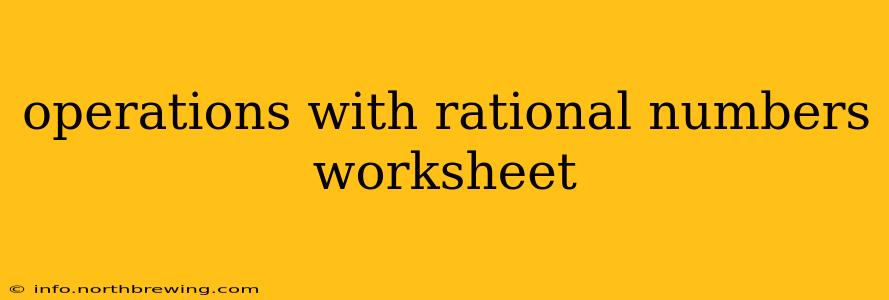Mastering Operations with Rational Numbers: A Comprehensive Worksheet Guide
This worksheet isn't just about solving problems; it's about understanding the fundamental principles of working with rational numbers. Rational numbers – any number that can be expressed as a fraction p/q, where p and q are integers, and q is not zero – form the bedrock of many mathematical concepts. This guide will walk you through the key operations, offering explanations and examples to solidify your understanding. We'll tackle addition, subtraction, multiplication, and division, ensuring you're comfortable with each.
What are Rational Numbers?
Before we dive into operations, let's briefly revisit what constitutes a rational number. Think of them as any number you can represent as a fraction. This includes:
- Integers: Whole numbers (positive, negative, and zero). For example, -3, 0, 5. These can be expressed as fractions (e.g., -3/1, 0/1, 5/1).
- Fractions: Numbers expressed as a ratio of two integers. For example, 1/2, -2/3, 7/4.
- Terminating Decimals: Decimals that end. For example, 0.75 (which is 3/4), 2.5 (which is 5/2).
- Repeating Decimals: Decimals with a pattern that repeats infinitely. For example, 0.333... (which is 1/3), 0.142857142857... (which is 1/7).
Numbers that aren't rational are called irrational numbers (like π or √2). They can't be expressed as a simple fraction.
Addition and Subtraction of Rational Numbers
Adding and subtracting rational numbers requires finding a common denominator. Let's illustrate:
Example 1: Adding Fractions
1/2 + 2/3 = ?
First, find the least common denominator (LCD) of 2 and 3, which is 6. Rewrite the fractions:
(1/2) * (3/3) + (2/3) * (2/2) = 3/6 + 4/6 = 7/6
Example 2: Subtracting Mixed Numbers
3 1/4 - 1 2/5 = ?
Convert the mixed numbers to improper fractions:
(13/4) - (7/5) = ?
Find the LCD (20):
(13/4) * (5/5) - (7/5) * (4/4) = 65/20 - 28/20 = 37/20 or 1 17/20
Example 3: Adding and Subtracting Negative Rational Numbers
-2/5 + 3/10 - 1/2 = ?
Find the LCD (10):
(-4/10) + (3/10) - (5/10) = -6/10 = -3/5
Multiplication of Rational Numbers
Multiplying rational numbers is straightforward: multiply the numerators and multiply the denominators. Simplify the resulting fraction if possible.
Example:
(2/3) * (-5/7) = -10/21
Division of Rational Numbers
Dividing rational numbers involves multiplying by the reciprocal of the second fraction (divisor).
Example:
(1/2) ÷ (3/4) = (1/2) * (4/3) = 4/6 = 2/3
Solving Real-World Problems with Rational Numbers
Rational numbers are used extensively in everyday life. Here are some examples:
- Cooking: Following recipes often requires working with fractions (e.g., 1/2 cup of sugar).
- Construction: Precise measurements in construction rely heavily on fractions and decimals.
- Finance: Calculating interest, discounts, and proportions often involves rational numbers.
Frequently Asked Questions (FAQs)
What is the difference between a rational and an irrational number?
Rational numbers can be expressed as a fraction p/q (where q ≠ 0), while irrational numbers cannot. Examples of irrational numbers include π (pi) and √2 (the square root of 2).
How do I find the least common denominator (LCD)?
The LCD is the smallest multiple that two or more denominators share. You can find it by listing multiples of each denominator or by finding the prime factorization of each denominator.
What if I have a mixed number? How do I work with it?
Convert mixed numbers into improper fractions before performing any operations. This simplifies calculations significantly.
Can I use a calculator for these operations?
While calculators can help with computations, understanding the underlying principles is crucial for mastering operations with rational numbers. Use a calculator to check your work, but prioritize solving the problems manually to build a strong conceptual understanding.
This guide provides a foundational understanding of operations with rational numbers. Consistent practice and attention to detail will solidify your skills. Remember to always simplify your answers to their lowest terms. Good luck!
